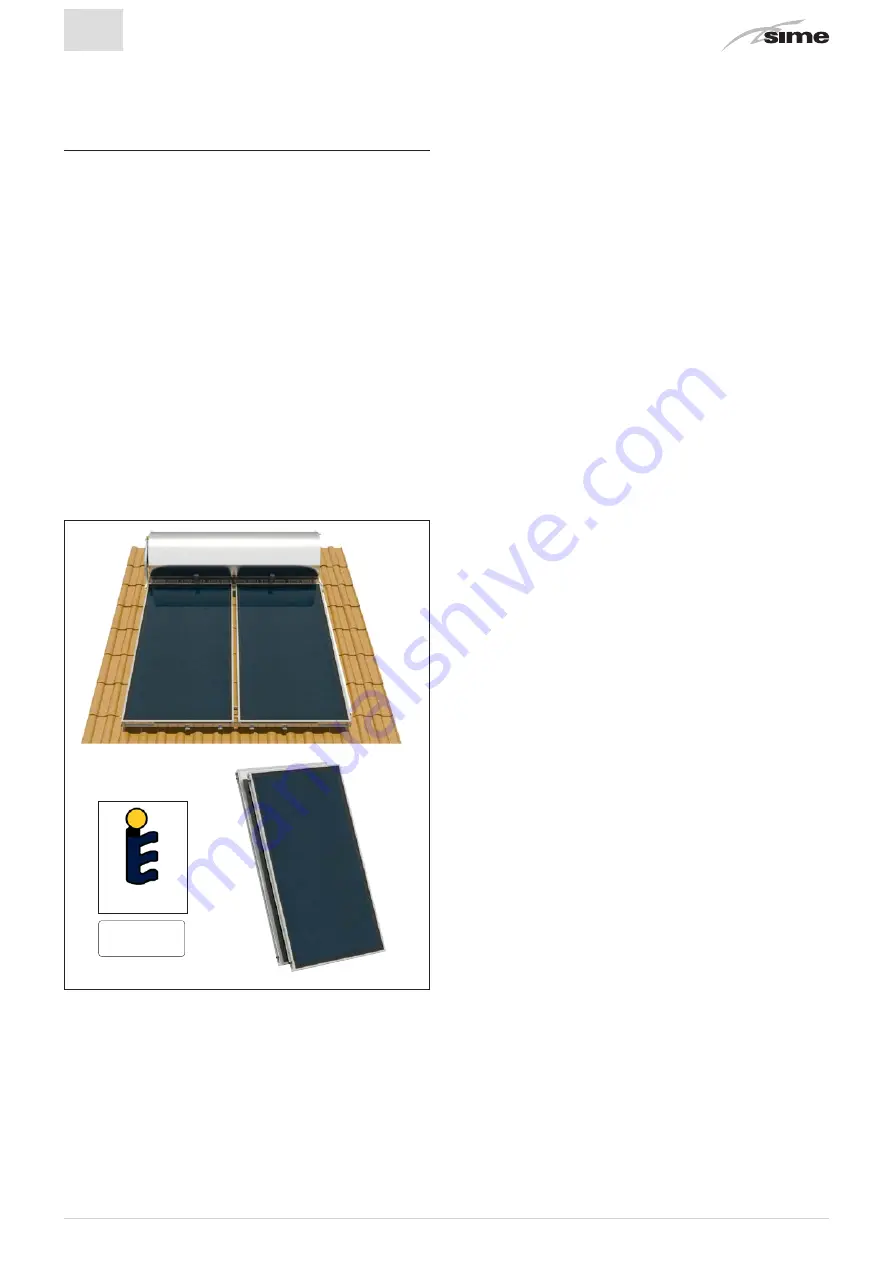
5
EN
1 DESCRIPTION OF THE APPLIANCE
1.1
Characteristics
“
Sime Natural S
” natural-circulation systems constitute an
eco-friendly and energy-efficient solution combining excellent
performances, extended autonomy, visual appeal, ease of instal-
lation and cost saving. They are built with suitable materials ac-
cording to international specifications and their quality is guaran-
teed by all the pertinent certifications obtained and the relevant
tests passed.
These aesthetically advanced systems are easy and quick to in-
stall. They blend into any architectural style of buildings, whether
traditional or more modern, and are able to provide hot water all
year round. Even in regions characterised by low levels of sunli-
ght, solar systems are nonetheless able to pre-heat the water,
which brings about a drastic reduction of conventional energy
consumption.
With the use of solar systems based on natural circulation, the
resulting energy saving ranges between 70% and 100%. At the
same time, depending on the amount of sunlight in the various
regions and the dimensions of the system, the calorifier or hea-
ting element works for less time, which helps to reduce carbon
dioxide emissions.
E 22
Certificazione
Solar Keymark
ANNI
DI
ANNI
DI
GARANZIA
GARANZIA
5
5
Solar Keymark
Certification
YEAR
WARRANTY
Fig. 1
1.1.1
General characteristics
Nowadays it is widely known that we have to produce and save
energy without however polluting the environment. The planet’s
conventional energy sources are running out at an alarming rate
while society’s energy requirements increase, generating pollu-
ting agents that threaten the climatic equilibrium.
Renewable energy sources are a possible solution to the ener-
gy problem but also to pollution. International legislation is gra-
dually changing and encouraging – or even enforcing – the use
of alternative energy products with the aim of satisfying energy
requirements without jeopardising the environment.
1.1.2
Domestic hot water requirement
Statistically it has been calculated that a family’s average consu-
mption hovers around 35–50 litres a day per person. If we add the
consumption of the washing machine and dishwasher if they have
been connected to the solar heating system, roughly 20 litres a
day are required for each appliance (for one wash).
A family of four, therefore, assuming an average consumption of
40 litres of hot water each, will need a 160-litre solar water he-
ater. If we add the household appliances connected to the solar
system, this requirement increases by at least 40 litres a day. In
order to take full advantage of the solar water heater, we must
use as much hot water as possible during the day, so that the sy-
stem can produce constantly when there is sunlight while main-
taining maximum performance.
1.1.3
Operation of the solar system - water heating
The surface of the collector, through the solar energy it absorbs,
heats the liquid (water or anti-freeze solution) that circulates in-
side the solar heating collector. The heated liquid becomes less
heavy and flows towards the calorifier, heating the water contai-
ned in it. The circulation of the liquid in the collectors is not for-
ced, but natural (thermos phonic effect).
There are numerous factors influencing the temperature of the
water supplied by a solar heating panel and their values oscillate
in relation to the season, the time of the day and the place.
Considering that the solar heating panel is a system exposed to
atmospheric conditions, the fundamental parameters that in-
fluence its performance include the temperature of the supply
water, the available solar energy and the outdoor temperature.
The temperature of the mains water does not remain constant
throughout the course of the year, since it is far cooler in winter
than in summer. If we take 45°C to be a satisfactory temperatu-
re for the domestic hot water (for satisfying the needs of a hou-
sehold), we infer from statistical data that the temperature of the
mains water should increase by 35°C during winter and by 20°C
during summer.
Moreover, the available solar energy does not remain constant
during the year, since in winter it is lower than in summer. When
there is a low amount of sunlight coupled with cool outdoor tem-
peratures, the solar panel ensures pre-heating and is assisted by
the use of the heating element or central heating boiler (triple-e-
nergy systems). Regarding heat losses during the night, these
are minimised by the system’s effective thermal insulation. The-
se losses naturally depend on the outdoor temperature, which
varies in relation to the place and the weather conditions.
Содержание 300/5.44 S
Страница 62: ...62 ...
Страница 63: ...63 ...
Страница 64: ...Fonderie Sime S p A Via Garbo 27 37045 Legnago Vr Tel 39 0442 631111 Fax 39 0442 631292 www sime it ...






































